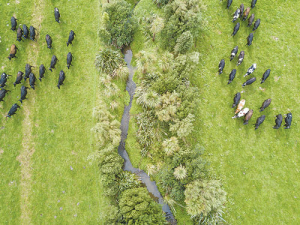Fencing will help to maintain and improve water quality and create a habitat for birds and freshwater species.
Fencing waterways is a priority under the Sustainable Dairying Water Accord.
All stock must be excluded from all lakes and any permanently flowing rivers, streams, drains and springs, more than 1m wide and 30cm deep.
Any significant wetlands, as identified in a regional plan or policy statement, must also have had all stock permanently excluded.
Waterway fencing must be far enough back to allow for movement/flooding of the waterway.
Start by mapping your waterways and create a fencing plan; consider the overall layout of your farm; along with protecting waterways, new fencing can improve grazing management and stock control.
Plan fence lines and crossing points; the area between the fence and waterway will slow runoff to ensure as much bacteria, phosphorus and sediment as possible is filtered out before entering the waterway.
Choose your fence setback depending on how you are going to manage the area. There are four main ways to manage your riparian areas as outlined below. All have the benefit of stock exclusion and reducing phosphorous and sediment from entering waterways.
Additional benefits and limitations for each option are listed below to help you decide on the fence setback that will best suit your needs.
Grass filter strip between fence and waterway
Additional benefits
- Low cost
- Small loss of grazing land
Limitations
- Weed control required
- No shading of stream
- Minimal habitat for bird and aquatic life
- Minimal bank stabilisation without deeper rooted vegetation.
Low planting between fence and waterway
Additional benefits
- Stream bank stability
- Small loss of grazing land
- Can make use of sprays targeted to broadleaf species
- Helps control weed growth
- Shade and cover for fish and insect life.
Limitations
- Weed control required
- Minimal habitat for birdlife
Full planting between fence and waterway
Additional benefits
- Reduced drain maintenance
- Attractive asset for your farm
- Provides shade and keeps water cool
- Increased habitat for birds.
Limitations
Higher cost
Larger loss of grazing land
Needs weed control for at least two to three years
May require animal pest control.
Extend fenced area to include seeps, wetlands, swamps and springs
Additional benefits
- Reduces stock losses
- Provide habitat for bird life.
Limitations
- May result in loss of grazing land
- Needs stringent weed control
- Higher cost if planting required
Fencing in flood prone areas
- Use fewer upright posts and less wire; this way less debris will catch on the fence. Do not use netting as it will trap debris.
- Put wires on the downstream back side of posts so that flood waters will cause the staples to pop and the wire drop rather than pull out the posts and strainers.
- Use unbarbed staples so wires can pop off more easily.
- Erect fences parallel with the way the stream floods so the fence does not collect debris.
- Have fences further back where active erosion is occurring
- Construct separate ‘blow-out’ sections across flood channels.
Access to drains
- Build an electric fence that can be dropped or removed to allow access, e.g. use pinlock insulators so the wires can easily be lowered for machinery to cross.
- Position the fence so a long-reach digger can reach over the top.
- For wide waterways, place a fence far enough back to allow a digger to work between the fence and the bank. This approach still allows for a wide grassy margin and you can plant low growing plants on the waterway margin if you wish.
- Do not cut off gateways that give diggers access to neighbouring paddocks.
• Article sourced from DairyNZ.
















